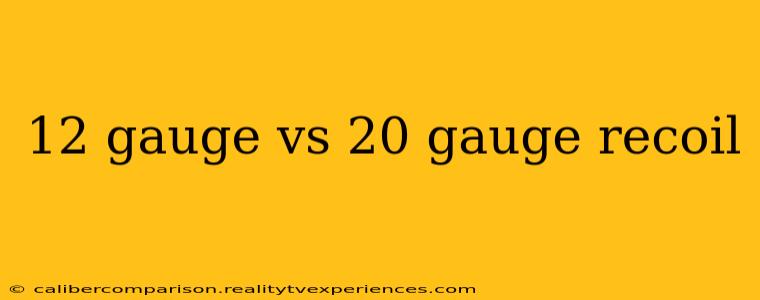Choosing between a 12-gauge and a 20-gauge shotgun often boils down to one key factor: recoil. This article will dissect the recoil differences between these popular gauges, exploring the physics behind the kick, the impact on different shooters, and ultimately helping you decide which gauge is right for you.
Understanding Recoil: The Physics of the Kick
Recoil, that backward push you feel when firing a shotgun, is a consequence of Newton's Third Law of Motion: for every action, there's an equal and opposite reaction. When the gunpowder ignites, the expanding gases propel the shot forward—and simultaneously push the gun backward into your shoulder. Several factors influence the magnitude of this recoil:
-
Gauge: The gauge number indicates the bore diameter of the shotgun barrel. A lower gauge number (like 12) means a larger bore and therefore a heavier shot charge, resulting in greater recoil. A 20-gauge has a smaller bore and less shot, leading to less recoil.
-
Shell Load: Even within a given gauge, the recoil varies depending on the shell's load. High-brass, magnum loads pack more powder and shot, increasing recoil significantly compared to low-brass target loads.
-
Gun Weight: Heavier shotguns absorb recoil more effectively, making the kick feel less jarring. A lighter shotgun will amplify the recoil's impact.
-
Stock Design: The design of the stock, including its length, drop (vertical angle), and cast (horizontal angle), impacts how the recoil is transferred to the shooter's shoulder. Properly fitted stocks can mitigate recoil significantly.
12 Gauge vs. 20 Gauge Recoil: A Direct Comparison
The key takeaway is simple: a 20-gauge shotgun generally produces significantly less recoil than a 12-gauge shotgun. This difference is noticeable even to experienced shooters, and is especially crucial for beginners, younger shooters, or those with physical limitations.
However, this doesn't mean the 20-gauge is always superior. The reduced recoil comes at the cost of reduced shot capacity and potentially less stopping power, particularly with heavier game.
Recoil's Impact on Different Shooters:
-
Beginners: The gentler recoil of a 20-gauge makes it an ideal choice for new shooters. It allows them to focus on proper shooting technique without being overwhelmed by the kick.
-
Youth Shooters: Younger and smaller shooters will find the 20-gauge much more manageable and comfortable to handle, preventing flinching and promoting better shooting habits.
-
Experienced Shooters: Experienced shooters might prefer the power and range offered by a 12-gauge, especially for hunting larger game. They often develop techniques to manage the recoil effectively.
-
Shooters with Physical Limitations: Individuals with shoulder or upper body injuries may find the reduced recoil of a 20-gauge much more comfortable and less painful to shoot.
Making the Right Choice: Gauge Selection Considerations
Choosing between a 12-gauge and a 20-gauge involves carefully considering your individual needs and preferences.
Factors to Consider:
-
Intended Use: Hunting large game (deer, turkey, etc.) might necessitate the greater power of a 12-gauge, while smaller game (quail, dove, etc.) can be effectively hunted with a 20-gauge. Sporting clays or trap shooting are well-suited to both gauges, depending on personal preference.
-
Physical Capabilities: If recoil management is a concern, the 20-gauge is the clear winner.
-
Shooting Experience: Beginners generally benefit from the lower recoil of the 20-gauge, allowing them to develop proper technique without discomfort.
-
Budget: Prices for shotguns vary depending on the gauge, manufacturer, and features.
Conclusion: Finding the Perfect Fit
Ultimately, the best gauge for you depends on your individual circumstances. While a 20-gauge offers reduced recoil, making it ideal for beginners and those sensitive to recoil, the 12-gauge provides more stopping power for larger game. Carefully consider your needs and preferences to make an informed decision. Don't hesitate to try both gauges at a shooting range to experience the recoil difference firsthand.

